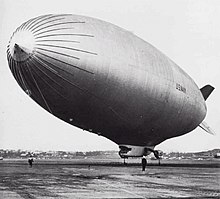From Wikipedia, the free encyclopedia
| N class | |
|---|---|
| Role | Patrol airship |
| Manufacturer | Goodyear Aircraft Corporation |
| Retired | 1962 |
| Status | Retired |
| Primary user | US Navy |
| Number built | 5 |
An initial contract was awarded to the Goodyear Aircraft Company for the prototype N-class blimp in the late 1940s, with delivery of the first on in 1952.[2] The ZPN-1 designation was changed to ZPG-1 in 1954, and then to SZ-1A in 1962. The envelope capacity for the ZPN-1 was 875,000 cu ft (24,777 m3) and used the gas helium for lift.
The ZPN-1 was followed by an order for four improved N-class blimps that were delivered in 1954. These airships were designated ZP2N, and re-designated in 1954 as the ZPG-2. Three of the ZP2N airships were modified for an airborne early warning mission in the mid-1950s and were designated, originally, ZP2N-1W but at delivery were designated ZPG-2W. Their designation was changed to EZ-1B in 1962. The envelope capacity of these airships exceeded 1×106 cu ft (28,317 m3). The ZPG-2W was equipped with the AN/APS-20 radar with its antenna, installed beneath the gondola. There was an APS-70 with its simple dipole antenna inside the envelope. An AN/APS-69 height-finding radar antenna was mounted on top of the envelope. The airship carried a crew of 21 to 25 and had an endurance of over 200 hours. Also, the engines were installed in the control car, driving the propellers through extended shafts. The first ZPG-2W was delivered to the Navy at NAS Lakehurst in May 1955.[1]
Operationally the ZPG-2W was used to fill radar gaps in the North American early warning network during the “cold war” between the Contiguous Barrier and the Inshore Barrier. In a demonstration of the ability to stay on-station for extended times, in a record making flight, a ZPG-2, sn 141561, flew a circuit non-stop from Naval Air Station Lakehurst, New Jersey to west Africa and onto Naval Air Station Key West, Florida covering a distance of 9,448 mi (15,205 km) in 264.2 hours. That flight exceeded the lighter than air distance record of 6,980 mi (11,233 km) set by the Graf Zeppelin in 1929. In March 1957, a ZPG-2, the "Snow Bird" piloted by Commander Jack Hunt, USN, took off from Naval Air Station South Weymouth, Massachusetts, and landed 10½ days later at NAS Key West, Florida. The airship with a crew of 13 set a new "distance record of 9,740 miles, and an endurance record without refueling.[1]
The follow-on and larger AEW blimp was the ZPG-3W, the largest non-rigid airship ever built. It was used to fill radar gaps in the North American early warning network during the Cold War between the Contiguous Barrier and the Inshore Barrier. The popular name for the ZPG-3W was Vigilance. The ZPG-3W was unique in that the huge antenna for the early warning radar was enclosed inside the helium filled envelope. Four airships were delivered to the U.S. Navy.[1]
The first flight of the ZPG-3W was in July 1958.[3] The envelope of the blimp was used as a radome for the 42 ft (12.8 m) radar antenna, thus providing the airship with a clean aerodynamic shape. The airship was over 400 ft (121.9 m) long and was almost 120 ft (36.6 m) high. The endurance time for the airship could extend for days.
The ZPG-3W was the last of the airships built for the U.S. Navy. The July 6, 1960, crash of a Lakehurst-based airship east of Long Beach Island killed 18 sailors, a loss that added pressure on the program. The Navy decommissioned its airship units at Naval Air Station Glynco, Brunswick, Georgia, and at Lakehurst on Oct. 31, 1961. On Aug. 31, 1962, the last two ZPG-3W ships made a ceremonial last flight over Lakehurst — the base log noted, “This flight terminates operation of non-rigid airships at Lakehurst,” Steingold said.[4]
The specially designed and built AN/APS-70 Radar with its massive 42 ft (12.8 m) internal antenna was the best airborne radar system built for detecting other aircraft because its low frequency penetrated weather and showed only the more electronically visible returns. A large radome on top of the envelope held the height finding radar.[1]
The control car of ZPG-3W number 2, BuNo 144243, was stored for many years at NAS Lakehurst. Recorded as in storage at the National Museum of Naval Aviation at Naval Air Station Pensacola, Florida awaiting restoration,[5] it had been in storage at AMARC / 309th Aerospace Maintenance and Regeneration Group at Davis-Monthan AFB, Arizona since at least 1993 until being relocated to NMNA at NAS Pensacola in 1995.
Under the 1962 unified Department of Defense air vehicle designation system the ZPG-3W was re-designated the EZ-1C.
In 1986, a ZPG-2W envelope was used for the construction of the Piasecki PA-97 Helistat.
Designation Systems
Under the designation system established in April 1947 the first N-class airships were given the Navy designation of ZPN-1, (Z = lighter-than-air; P = patrol; N = type/class). In April 1954, the designation system was changed to mimic that used for heavier-than-air aircraft. With this change the designation for the ZPN-1 became the ZPG-1 (Z = lighter-than-air; P = patrol; G=Goodyear; 1=first version). In the 1962 system the ZPG-1 designation was changed to SZ-1A (S=anti-submarine warfare; Z=lighter-than-air type; 1=first vehicle in the type; A=first model in the series). The designations for later model blimps followed similarly.Specifications (ZPG-2W)
General characteristics- Crew: 21
- Length: 343 ft 0 in (104.57 m)
- Diameter: 76 ft 0 in (23.17 m)
- Height: 107 ft 0 in (32.62 m)
- Volume: 1,011,000 ft3 (23,648 m3)
- Powerplant: 2 × Wright R-1300-4,-4A radials,, 800 hp (600 kW) each
- Maximum speed: 80 mph (128 km/h)
- Endurance: over 200 hours


No comments:
Post a Comment